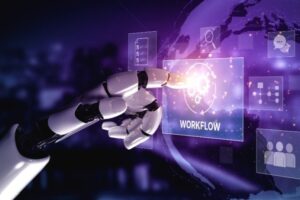
AI For Students’ Success: Your Implementation Playbook

Generative AI Integration In Higher Education For Student Success
Let’s be honest: the arrival of generative AI has felt like a tidal wave. While many of us have been cautiously experimenting or creating fragmented policies, our students have dived in headfirst. A passive approach is no longer an option. The rapid adoption of AI tools and the demands of a new skills-based economy require a bold, institution-wide strategy. This isn’t just another report. It’s a playbook. We’ll show you how to move from a defensive crouch to a proactive transformation, turning your institution into a value-driven university.
The core idea is simple: let’s borrow from the startup world and focus relentlessly on what our students are trying to achieve—what we call their “Jobs to Be Done.” For most, that boils down to two things: landing a great career or launching an innovative venture.
This playbook offers a clear roadmap to use generative AI as an enterprise-wide tool to deliver on that promise. We’ll cover the strategy, the execution, the risks, and the long-term vision. This isn’t about replacing the human element of education; it’s about using technology to amplify it, freeing up your people to do what they do best: inspire, mentor, and innovate.
Why We Need A New Game Plan
The genAI revolution is not just an upgrade to your existing tech; it’s a fundamental paradigm shift. Unlike a search engine that finds existing information, genAI creates new content—text, images, code, you name it. For students, it’s a brainstorming partner. For faculty, it’s a teaching assistant. For administrators, it’s a tool to automate countless tasks.
But the scattered, unguided use of free AI tools creates a chaotic environment filled with risks around academic integrity, data privacy, and equity. Trying to ban or detect our way out of this is a losing battle. The only way forward is a proactive, enterprise-level strategy. To build one, we need to think like a startup, and that means using two powerful tools: the Value Proposition Canvas and the Business Model Canvas.
-
The Value Proposition Canvas (VPC)
This is a simple map that forces you to answer two questions: “What do our students really need?” and “How can we deliver that?” It shifts the focus from our internal offerings (“we have a great curriculum”) to the students’ external goals, pains, and desired gains.
-
The Business Model Canvas (BMC)
This is the one-page blueprint that connects your value proposition to your day-to-day operations. It maps out everything from your key resources (like genAI platforms) and activities (like personalized advising) to how these deliver value and ensure your institution thrives.
What Do Students Actually Want? Crafting Your AI Value Proposition
Generative AI isn’t the goal; it’s the vehicle for delivering more value. When we apply the startup mindset, we see two critical “Jobs to Be Done” for today’s students: achieving career-readiness and developing an entrepreneurial spirit.
The Employability Proposition: Skills First, Degree Second
The job market has changed. Employers now prioritize verifiable skills over degrees alone. It’s no longer enough to offer a diploma; we must offer a clear path to the skills that get students hired.
Student’s job: Get a meaningful, high-value job right after graduation.
Their pains: Fearing their classroom skills won’t translate to the real world, feeling anxious about interviews, and lacking a professional network.
Their gains: A tangible portfolio of projects, verified skills and micro-credentials, and mentorship from industry pros.
How genAI helps: We can use AI to build a value proposition that directly addresses this. Imagine AI-powered career platforms that offer personalized guidance, AI interview simulators for safe practice, and AI co-pilots that help students build stunning project portfolios. We can use AI to analyze millions of job postings in real time, helping faculty tweak curricula to match market demand instantly.
The Entrepreneurship Proposition: Building An Innovation Hub
Beyond preparing students for existing jobs, we must empower them to create the jobs of the future. A university can be a powerful incubator for innovation.
Student’s job: Turn a great idea into a real product, get funding, and find mentors.
Their pains: Lacking business know-how, struggling with the technical side of building a prototype, and having limited access to investors.
Their gains: A supportive, structured process for launching a venture, hands-on experience, and access to a network of entrepreneurs and investors.
How genAI helps: GenAI can dramatically lower the barriers to starting a business. AI co-pilots can help draft business plans, write initial code, and create financial models. AI platforms can connect student founders with the right co-founders and mentors across campus and even showcase their digital portfolios to a network of affiliated investors.
For The Career-Focused Student
Goal: To secure a high-value job, gain work experience, and build a professional network.
Challenge: They feel their skills are disconnected from the job market, face intense competition, and are uncertain about their career path.
AI-powered solution: The university offers AI-driven career guidance and interview simulators. It uses AI to align the curriculum with real-time job demands and helps students create strong portfolios with verifiable digital credentials.
For The Aspiring Entrepreneur
Goal: To develop a business idea, build a prototype, secure funding, and find mentors.
Challenge: They often lack business knowledge, access to capital, and expert advice, and they fear failure.
AI-powered solution: The university provides AI co-pilots to help create business plans and prototypes. It also uses AI to simulate investor pitches and connects students with mentors, co-founders, and funding opportunities.
Architecting Your University’s AI Engine
Delivering on these promises requires a robust and integrated tech infrastructure. A siloed approach where every department buys its own AI tool just won’t work. We need a cohesive digital ecosystem where data flows seamlessly to power intelligent tools for everyone.
Building The Technical Foundation
Success with AI is a data challenge. We must break down the data silos between our Learning Management System (LMS), student information system (SIS), and other platforms. This integrated data layer is the fuel for everything that follows.
- GenAI-infused LMS
Your LMS can transform from a passive file cabinet into an active learning hub. Generative AI can help faculty auto-generate quizzes and content, create personalized learning paths for students, and provide 24/7 support via AI tutors. - Intelligent SIS
AI can automate routine administrative tasks within your SIS, like processing forms and guiding students through registration, freeing up staff for high-touch student interactions. - The power of predictive analytics
When you combine LMS and SIS data, you can move from being reactive to proactive. Predictive models can identify at-risk students before they fall behind, allowing for timely intervention from advisors and faculty.
The Faculty Co-Pilot: A Teacher’s New Best Friend
Generative AI doesn’t replace faculty; it augments them. Think of it as a powerful co-pilot that handles the routine work so instructors can focus on what matters most: fostering critical thinking, creativity, and mentorship.
- Smarter course design
AI can help faculty outline a new course, draft learning objectives, generate case studies, and create differentiated content for diverse learners—all in a fraction of the time it would take manually. - “AI-resilient” assessments
Instead of fighting AI, faculty can use it to design more authentic assessments. AI can generate complex, real-world scenarios, create detailed project rubrics, and build large banks of quiz questions that test application, not just recall. - Less administrative busywork
One of the biggest wins is automating tedious tasks. GenAI can draft routine emails, compose letters of recommendation, and provide high-quality initial feedback on student writing, freeing up hours each week for more meaningful student interaction.
Navigating The AI Minefield
The transformative power of genAI comes with serious challenges. A responsible rollout requires a robust governance framework to manage the ethical, operational, and pedagogical risks.
A Framework For Ethical And Responsible Use
Data Privacy Is Non-Negotiable
When students use free AI tools, their data can become part of the public model. Rule #1: Any information that isn’t already public should never be put into a free genAI platform. The solution is to invest in secure, enterprise-grade AI platforms with contractual privacy guarantees.
Confronting Algorithmic Bias
AI models can perpetuate and amplify societal biases found in their training data, potentially leading to discriminatory outcomes for marginalized students. To fight this, we need transparency from vendors, regular audits of our AI systems, and a “human-in-the-loop” for all high-stakes decisions. An algorithm can suggest, but a person must decide.
Bridging The Digital Divide
We must ensure genAI doesn’t create a new class of have-nots. Digital equity means providing all students with universal access to powerful, institution-licensed AI tools, reliable internet, and the training to use them effectively.
Upholding Academic Integrity In The Age Of AI
The knee-jerk reaction is to focus on catching cheaters. That’s a mistake. AI detection tools are notoriously unreliable and often biased. The real solution is pedagogical, not technological. We must redesign assessments to be “AI-resilient”—meaning they are difficult to complete meaningfully with AI alone. This means shifting toward:
- Process-based assessment
Grade the steps, not just the final product (e.g., annotated bibliographies, drafts, reflective memos). - In-class activities
Use in-class essays, oral presentations, and live debates to verify understanding. - Authentic, real-world problems
Design assignments that require students to apply concepts to their personal experiences or local contexts.
Finally, be clear and transparent. Every syllabus should have a policy on AI use, which can range from “AI Prohibited” to “AI Encouraged with Citation.” The goal is to teach students how to use these tools responsibly, just as they will in the modern workplace.
Key Takeaways: Managing GenAI Risks In Education
- Data privacy and security
To protect student and institutional data, prohibit the use of public AI tools for sensitive information and invest in secure, enterprise-level AI licenses with contractual privacy guarantees. - Algorithmic bias
To prevent AI from amplifying societal biases against marginalized students, form an ethics review board, conduct regular audits, and always keep a “human-in-the-loop” for critical decisions like admissions. - Academic integrity
To uphold academic integrity, focus on redesigning assignments to require critical thinking and make them “AI-resilient,” rather than relying on flawed AI detection software. - Digital divide and equity
To ensure fairness, the institution must provide all students with universal access to a standard set of powerful, enterprise-licensed AI tools, preventing a “pay-to-win” environment. - Cognitive offloading
To prevent students from simply outsourcing their thinking to AI, design assignments that require them to actively critique, verify, and improve AI-generated content, thereby fostering critical engagement.
Your Roadmap To An AI-Powered Future
This transformation is a multi-year journey, not a sprint. A phased approach allows you to build momentum, learn as you go, and get buy-in from your entire community.
Phase 1: Foundation And Exploration (Year 1)
- Governance
Establish a cross-functional AI task force with faculty, IT, legal, and students. - Policy
Conduct a readiness assessment and develop foundational ethical guidelines and data governance policies. - Pilots
Launch a few low-risk, high-impact pilot programs (e.g., an AI chatbot for one department) and roll out AI literacy training for leadership.
Phase 2: Integration And Scaling (Years 2–3)
- Tech integration
Strategically infuse genAI capabilities into your core systems like the LMS and SIS. - Scale up
Expand successful pilot programs to more departments. - Pedagogy
Launch comprehensive faculty development programs on redesigning courses and assessments for the AI era.
Phase 3: Transformation And Optimization (Years 4–5)
- Full ecosystem
Achieve a fully integrated digital ecosystem that enables sophisticated, personalized student experiences. - Data-driven strategy
Use predictive analytics as a core part of institutional decision making. - Continuous improvement
Establish a permanent governance body to monitor and refine your AI systems, ensuring your university is agile, resilient, and ready for whatever comes next.
The Future: Your New Competitive Advantage
The journey is challenging, but the reward is a sustainable competitive advantage. The value-driven university will attract and retain top talent because it delivers demonstrable outcomes. It will be more agile, efficient, and resilient, able to adapt quickly to the evolving needs of the workforce.
Ultimately, this is about harnessing technology to amplify our greatest asset: our people. By automating the routine, genAI frees faculty, staff, and students to focus on the uniquely human skills of creativity, critical inquiry, and collaborative innovation. The value-driven university will be a place that prepares graduates not just to work in an AI-augmented future, but to lead and shape it.
Source link



